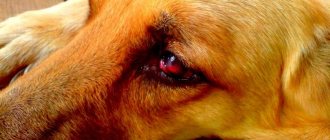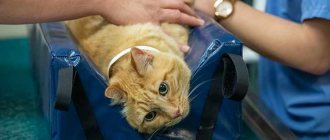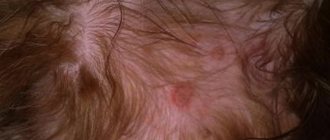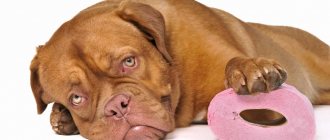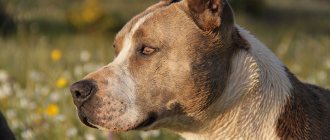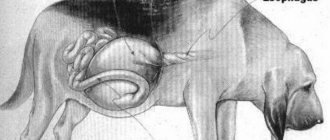In the article I will look at the main reasons that cause redness and squelching sounds in the ear, and I will explain why the dog shakes its head and ears, why the dog’s ear is red and smells, it hurts, and what to do. I will pay special attention to the necessary treatment, how to treat it at home, and also tell you which ear is considered healthy.
Causes of redness and squelching in dogs' ears
If your pet's ears appear red or squelching, then one of the following reasons occurs:
Foreign object
The most harmless reason is irritation caused by hairs or other small objects caught in the ear and the pet may constantly scratch the ear.
Carelessness while swimming
Water stuck in the ear canal leads to inflammation.
A fungal or bacterial infection can also cause redness
Allergic reaction
The appearance of red spots is a clear sign of a food allergy.
The ear may become flaky and red, and the dog may begin to whine from itching. Avoid table handouts. Sweets and any human dishes flavored with aromatic spices are dangerous for a dog’s stomach.
Ear ventilation problems
Fold-eared breeds (dachshunds, spaniels, basset hounds) with long hair lack air flow.
The ears, closed from external influences, accumulate excessive amounts of moisture, which attracts pathogens. Due to inflammatory processes, redness appears, and squelching sounds signal the appearance of suppuration.
Otodectosis
Ear mites feeding on the epidermis cause severe itching.
The animal may itch and tear the itchy area into blood. The released sulfur has a dark color, a pungent odor and a grainy structure.
Otitis
The abundant secretion of sulfur gives way to pus, and an unpleasant odor emanates from the sinks. In advanced cases, the dog may lose hearing or suffer brain damage.
Prevention
For food allergies, the main preventative measures are the following:
- If a reaction appears to a new type of food, it should be removed from the dog’s diet;
- Do not give your pet “goodies”: eggs, sweets, chicken, smoked meats, chocolate;
- Feed your dog only premium dry and wet food;
- Carefully study the composition of dog food;
- Natural foods (meat, cereals) that are ideal for feeding include rice cereal, lamb, rabbit, and turkey meat. These products are dietary, since they almost never cause pathological reactions in the dog’s body;
- You should choose your diet extremely carefully and always be on guard. Allergies do not always manifest themselves from the very first feeding.
Preventive measures for chemical allergies:
- Study the chemical composition of care products, medicinal and prophylactic agents;
- If you are allergic to flea and tick collars, be sure to stop using them immediately;
- Before vaccination and use of medications, conduct an allergy test;
- To care for your animal, use only hypoallergenic shampoos and lotions for animals.
- The use of human shampoos is strictly prohibited, as they are powerful allergens for sensitive pugs.
Prevention of environmental allergies:
- Once every 6 months, mandatory deworming (taking medication for worms). The drug should be purchased at a veterinary pharmacy. Before purchasing, you need to know the dog’s body weight, since the dosage of the drug is calculated based on this indicator;
- During tick season, you should wear a flea and tick collar (unless you have a chemical allergy to the components of the collar) or use drops prescribed by your veterinarian;
- Flea prevention is similar to tick prevention;
- Frequent wet cleaning of the premises where the dog lives is also important. It is important to get rid of dust and mold;
- Particular attention should be paid to your pet's ears. Examination and cleaning of the ears will help in finding mites, as well as purulent-inflammatory processes, which will help in the timely initiation of treatment for the pug and its rapid recovery;
- When an allergy-causing plant blooms, it is necessary to isolate your pet from the allergen as much as possible.
What to do if there is redness and itching inside the ear
In case of redness and itching, you need to understand the cause of concern, since further treatment will differ:
Foreign object
Gently clean the ear canal with a cotton swab. If the object is large (insect), then tweezers will help in removing it. Remember that if you have any doubts, your veterinarian will help you solve the problem.
The best option is to take the dog to a veterinary hospital.
Carelessness while swimming
In this case, you will have to use anti-inflammatory drugs prescribed by your doctor. To avoid unpleasant consequences, thoroughly wipe your dog's ears and absorb excess water using cotton pads.
Allergic reaction
In case of individual intolerance identified when changing food, immediately eliminate the allergen. If you cannot identify a dangerous product yourself, consult a doctor. During treatment, the pet takes a course of antihistamines and is transferred to a temporary hypoallergenic diet.
Ear ventilation problems
Lift the dog's ears by securing them together with medical tape. This technique will help improve air circulation. In this case, you cannot do without medical consultation, since the inflammation has already begun. Trim ear hair that interferes with air movement.
Otodectosis
Treatment is carried out after preliminary diagnosis.
As a rule, the veterinarian prescribes complex medications that relieve inflammation and pain, as well as fight infection and parasites.
Otitis
In the case of otitis media, medical intervention cannot be avoided, as the disease can develop into a chronic one.
If the middle and inner ear are damaged, the animal may lose orientation in space
First aid
If you notice reddened ears on your pet that are pressed to the head, try to determine the root cause and the symptoms accompanying this condition. If the reason is visible to the naked eye, you can try to figure it out yourself:
- If irritation occurs due to overgrown fur, simply remove it and in a few days the normal color will return and the itching will disappear.
- If a foreign body gets in , try to remove it yourself if it is visible to the naked eye. Otherwise, contact your veterinarian.
- A tick that has attached itself after a walk can also be removed at home. In this case, you need to monitor the redness and, if it does not disappear soon, contact the clinic.
- In case of an allergic reaction , give the animal one dose of an antihistamine, carefully calculating it taking into account the weight and size of the dog, and then gradually determine the cause, removing all recent innovations one by one.
In all other cases, independent attempts at treatment can only aggravate the pet’s condition and lead to serious consequences that cannot be eliminated.
Reasons why a dog shakes its head and ears
If your pet behaves restlessly and often shakes its head and ears, then a possible reason for this behavior lies in:
- foreign body;
- accumulated water;
- the injury received;
- neoplasms;
- helminthic infestation;
- blood-sucking insects.
- otodectosis;
- chlamydia;
- otitis.
This parasite lives in the animal's ear canals, and in the inside of the ear.
From the above examples, it can be seen that redness, squelching and head shaking are symptoms that occur with similar diseases and problems.
Let's take a closer look at the excellent reasons:
Injury
When a pet is injured in the head, vomiting is observed due to the resulting concussion. The movement of the head is due to an attempt to regain consciousness and maintain balance.
Neoplasms
Even harmless papillomas can become a serious problem if they accumulate excessively and cause blockage of the ear canal.
Helminthiasis
Helminths that infect the eyeballs impair visual function, so the animal, shaking its head, tries to restore the usual sharpness of vision. If there is a cough or other problems with the respiratory system, parasites affect the internal parts.
Blood-sucking insects
Lice and fleas that feed on the owner's blood cause severe itching, so the pet literally tries to shake them off the head.
Chlamydia
Bacterial damage can be recognized by tearing and sneezing. Try using acaricidal drugs and if there is no response, be sure to consult a doctor.
Under certain conditions, even ordinary water is fraught with disastrous consequences. For example, salt water causes burns, and water from a stagnant body of water is teeming with bacteria.
Close-up view of middle ear inflammation in a dog
Causes of the disease
The main cause of allergies in pugs is considered to be an innate predisposition. For effective treatment and prevention of the disease, it is necessary to distinguish between the types of allergic reactions. There are 4 main types of allergies in pugs:
- Food;
- Chemical;
- Insect;
- Ecological.
Based on this classification, the main causes of allergies in pugs can be identified: poor nutrition, high protein content in the diet, medication treatment, the body’s defense reactions to seasonal flowering of plants, autoimmune processes, insect bites, exposure to chemical animal care products.
It is difficult to identify the cause of allergic manifestations; for this you need to undergo diagnostics. Often, several days may pass from contact with the allergen to the first signs.
How to treat red ear at home
Any problems with the ears are fraught with unpleasant consequences, so do not ignore alarming symptoms.
It is not always possible to help your pet on your own, and self-diagnosis is often erroneous.
If there are alarming symptoms, take your dog to the veterinary clinic, where doctors will analyze the ear scraping. Laboratory analysis will indicate the correct diagnosis and help prescribe the correct treatment.
Depending on the diagnosis, use:
- antibiotics (erythromycin);
- antiparasitic (amidel-gel, dekta) and antibacterial (surolan, tetracycline ointment);
- anti-inflammatory and other medications.
Erythromycin ointment
Allergy symptoms
Signs of the disease do not depend on the type of allergen, but are common to all types of allergies. Pugs suffer from pronounced symptoms, the main of which are:
- Drowsiness, low activity, lethargy, apathy;
- Itching and redness of the skin, the dog is constantly itching;
- Swelling in areas of inflammation;
- Baldness in affected areas;
- Increased formation of dandruff;
- Digestive problems, possible diarrhea and constipation;
- The formation of pimples and pustules is possible.
Dogs' eyes also often become cloudy and red. Pugs have a hard time with this period, so if you have one of the symptoms, you should immediately contact a specialist. Separately, it is worth mentioning the signs of allergies in pugs on the ears, which is very common in this breed.
Other Features
- Seasonal shedding , in which dogs shed excess hair to facilitate thermoregulation. It is possible that shedding began precisely in the ear area.
- Thermal injuries (burns, frostbite) disrupt the structure of the skin, and it begins to peel off, thus getting rid of the damaged areas. The ears also become red.
- Lack of protein , which makes up any tissue of a living organism. If a pet leads an active lifestyle, its need for protein is higher. To restore muscles and bone tissue, in the absence of a sufficient amount of protein in food, it will destroy what it considers unnecessary tissue, converting it into nutrients.
- Deficiency of calcium and fiber , which also makes up the skin. Not only for construction, but also for maintaining all tissues, resources are needed.
- Stress. The fact is that the elements of the nervous system also consist of protein, calcium, sodium, fluorine and iron. Some elements are synthesized in a dog’s body in limited quantities and are used to restore the nervous system after stressful situations. Thus all tissues are deficient. The central nervous system has the highest priority among all systems, since it is a kind of “boss” of the body.
- Peeling can be caused by microclimatic conditions . If the house has air conditioning and it’s hot outside, the dog’s body will perceive this as a sharp change in the temperature of the environment and adapt its skin to protect itself. Some breeds are especially susceptible to this factor.
- In puppies during the period of active growth, peeling is observed due to the restructuring of the epidermal layer . New hairs are born in it, sebaceous glands are formed, and neural connections between receptors and skin are established. This changes the integrity of the cover, forming microtraumas that become covered with a fine crust, similar to a husk for us.
REFERENCE! General strengthening measures for peeling include taking vitamin complexes, lotions of natural herbal decoctions, including animal cartilage and joints rich in gelatin in the diet, stabilizing the rest and wakefulness regime, and active walks.
These tips will help not only with skin diseases, but also with strengthening general health and immunity .
Signs of a dog's hearing organ disease
A red ear inside a dog is the first sign of illness in the animal’s hearing organs. If the dog shakes its head, lowers it to its side, constantly scratches the parotid area, there is abundant sulfur discharge accompanied by an unpleasant odor, and the ear itself “squelches”, and, on top of everything else, the pet behaves nervously, eats and sleeps poorly, then there is fact of animal ear disease.
The signs of canine ear diseases are similar to each other, so it is not advisable to self-medicate, but it is better to seek help from a veterinarian who will make an accurate diagnosis and prescribe the necessary treatment.
Dog owner's home first aid kit
.
Experienced dog breeders usually make their own list of medications that should always be at home. But most recommend having the following medications and ear care supplies on hand:
- cotton pads;
- gauze napkins;
- cotton buds;
- ear lotion;
- ear powder with antipruritic effect;
- camphor oil;
- alcohol;
- baby moisturizing wipes;
- sofradex, ordermil ioi otipax;
- dexamethasone drops for dogs poured into the ears.
Video. Dog ear cleaning
For a dog, hearing and smell are very important. These sense organs are more developed than others. The owner must monitor the condition of the pet's ears very carefully and, if necessary, clean them. Normally, the inner surface of the ear in dogs is pale pink and odorless, but since the ears are one of the problem areas in almost all dogs, sometimes their inner surface turns red.
Why does my skin peel?
The skin is an integral organ of the immune system, which consists of many elements: epithelium, endothelium, hair, sebaceous glands . Their joint work regulates the body’s defense functions, and disruption of at least one component results in a general loss of immunity and frequent illnesses.
Causes of lesions inside the ear
- Seborrhea (dandruff) caused by nutritional imbalance, pests (check your ears, there may be mites there).
- Thermal or mechanical injuries. If your dog has damaged the area of skin behind the ear, it will peel as it heals.
- Disruption of the sebaceous glands. When they produce too little sebum, the skin becomes dry and flaky.
- Allergic reactions to medications or food.
But why the skin suffers only on the ears is a separate question. If the rest of the body is healthy and unharmed, then the ears are a place weakened by certain factors . This can be either inflammation or pathogens.
Red or dirty
Inspect your ears for dirt; it is quite possible that the dirt that came from the street contained toxins or toxic substances .
If there is plaque on the ears, redness, unpleasant odor, swelling, this indicates the presence of a disease that needs to be diagnosed. REFERENCE! During the period of sexual heat, some breeds are subject to changes in the body to attract a partner. Thus, the glands that secrete enzymes work in overdrive, which causes the release of secretions onto the skin, which exfoliates in response.


